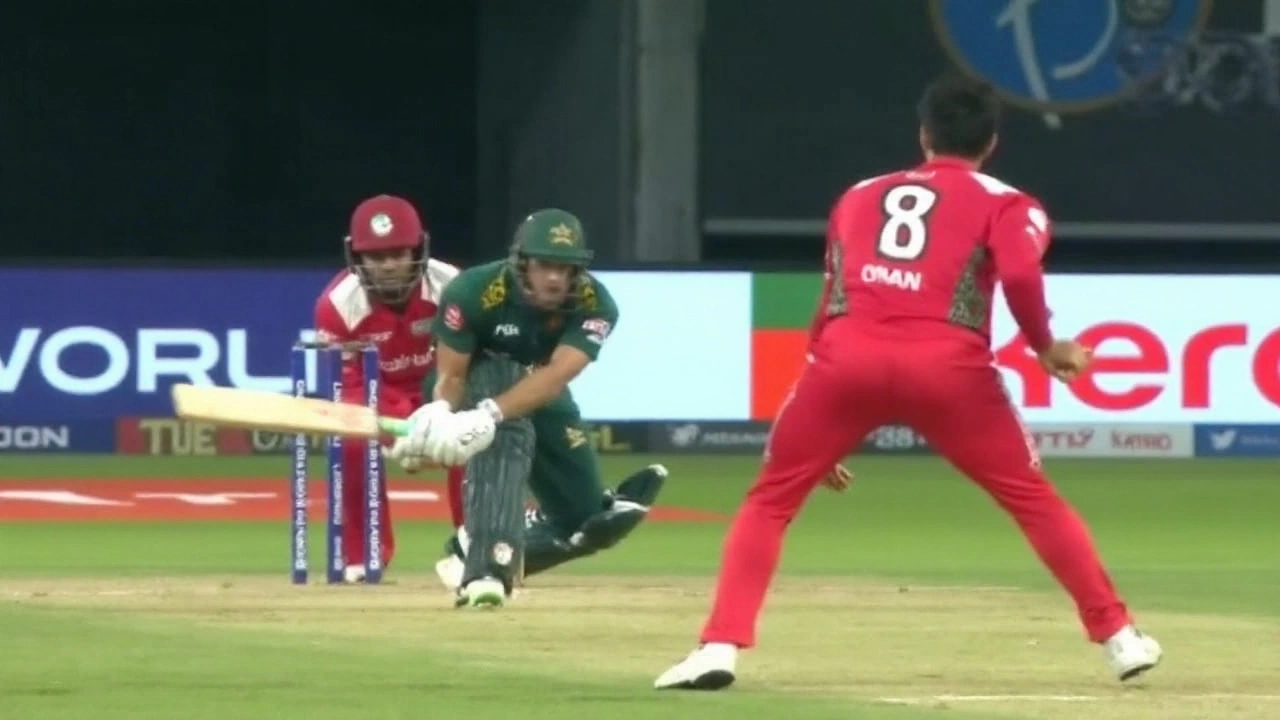Big win, familiar jitters: Pakistan start fast but worry the same old way
A 93-run win should ease nerves. It didn’t. Pakistan brushed Oman aside to open their Asia Cup 2025 with a comfortable result in Dubai, yet the scoreboard hid the unease that spread through their batting. Captain Salman Agha chose to bat first after winning the toss—brave on a ground where chasing often looks simpler—and his side crept to 160 for 7 in 20 overs on a surface that had more runs in it.
Mohammad Haris held the innings together. His 66 off 43 balls—seven fours, three sixes—was crisp, busy, and clear-headed. He picked his match-ups, swept hard, and punished anything too full. He also did most of the heavy lifting. Around him, Pakistan never settled. Sahibzada Farhan’s 29 looked neat without being assertive. Fakhar Zaman finished 23 not out but arrived too late to build a match-shaping stand. Wickets kept clipping Pakistan’s momentum at awkward times, the kind of stop-start rhythm that strong attacks feast on.
The middle overs were the pinch point again. After a serviceable powerplay, Pakistan got stuck between milking singles and forcing boundaries. Oman sensed it and tightened the screws. Aamir Kaleem and Shah Faisal did the damage, three wickets each, and both bowled like they had a plan. Kaleem’s left-arm spin kept sliding into the pads with the field packed smartly on the leg side; Faisal changed pace cleverly and took pace off at the right moments. Pakistan’s hitters chased lengths instead of forcing bowlers off theirs, and Dubai’s big square boundaries magnified every mis-hit.
It left the total feeling light. On a normal Dubai evening with a true pitch and short straight boundaries, 160 is par at best, often under. Pakistan owed their number to Haris’s timing and the handful of blows in the final two overs. What they lacked was a 40-run partnership in the middle or a burst of 12-15 an over when Oman’s fourth and fifth bowlers came on. Those are the passages that separate a solid day from a dominant one.
There were bright spots even in the stutter. Haris’s game looked rounded—he attacked spin early, then cooled down to farm strike, then burst again at the death. Farhan’s setup against the new ball remains compact; he just needs to lift his gear once set. Fakhar, stationed deeper in the order, provided stability at the end but never truly flipped the switch. And Salman Agha’s intent to front-load with batters and then smother with spin was obvious from the first team sheet.
That bowling plan clicked from ball one. Pakistan leaned heavily on spin, and the ball obeyed. Saim Ayub, used as a surprise option, pried out early wickets. Sufiyan Muqeem’s left-arm wrist-spin turned the knife, cramping Oman’s right-handers with the wrong’un. Abrar Ahmed came on to close the door. With Faheem Ashraf banging in cross-seamers and soaking up the change-of-pace work from one end, Oman were squeezed until the chase collapsed on itself.
Oman were bowled out for 67 in 16.4 overs. Hammad Mirza’s 27 was the only innings that threatened to stretch beyond containment. He tried to target the straight boundary and pierce midwicket, but Pakistan’s spinners kept dragging the length back and forcing him to hit across the line. Once he fell, the end felt quick. Edges carried to slip and short midwicket, one skier swirled to long-on, and Abrar ticked off the final wicket.
The gulf in bowling depth was stark. Pakistan had three spin options to cycle through angles and speeds. Oman had one main spinner to lean on, and once Kaleem was out of his spell, Salman’s batters could pick off the fifth bowler. The difference showed in how quickly Pakistan recovered after losing wickets versus how Oman froze after losing theirs.
- Pakistan: 160/7 in 20 overs (Mohammad Haris 66 off 43; Aamir Kaleem 3/31, Shah Faisal 3/34)
- Oman: 67 all out in 16.4 overs (Hammad Mirza 27; Saim Ayub 2 wickets, Sufiyan Muqeem 2, Faheem Ashraf 2; Abrar Ahmed took the final wicket)
- Result: Pakistan won by 93 runs; moved to second on the points table behind India on net run rate
So where does this leave Pakistan before India on September 14? Confident with the ball, cautious with the bat. The bowling looks in sync with the conditions: three spinners who offer different shapes, a seam-bowling allrounder who hits the pitch and hides the ball, and enough fielding intensity to turn half-chances into pressure. In Dubai, that’s a reliable template.
The batting is a different conversation. The issue isn’t talent; it’s tempo. When Pakistan lost a wicket, the next batter often needed 6–8 balls to get going. That’s normal against high-class attacks. It’s costly against an associate team on a truer deck. Against India, those sighters will not be cheap. Dot balls pile up, and then the release shot has to come against better pace and craft.
Roles need sharpening. If Haris is the pace-setter, someone has to be the bridge—bat through overs 7–14, keep the board at eight-and-a-half, and cash in one bad over. At the moment, the bridge is missing. Farhan’s timing points him toward that job. Fakhar, if used in the middle, must pick a must-attack bowler each game and go hard in his first 10 balls, not the last. Salman’s value is in busy runs; he can turn ones into twos and protect the man in form. That mindset shift turns a 160 night into a 180 night.
Match-ups also matter. Oman succeeded because they controlled angles to right-handers and shoved Pakistan to the bigger side. India will try the same with higher pace and superior wrist-spin. Expect the short ball into the body to set the field for the slower one wide, and expect the legspinner to attack the stumps with long-on and deep midwicket in play. Pakistan can answer by pre-committing to options: the sweep early to break fields, the drop-and-run to short third and cover, and the willingness to take 1–1–2 sequences rather than hunting a boundary every third ball.
Selection-wise, Pakistan found a structure they’ll like in these conditions: spin first, seam as the change, athletic fielders in catching positions. The call that remains is at the top: do they want a fast start with variance, or a calmer powerplay that sets the table for the middle overs? If they pick the first, Haris plus a dasher makes sense and the middle must accept occasional rebuilds. If they pick the second, Farhan’s quieter value goes up and the finishers must deliver 50 off the last five overs consistently.
There were tactical wins worth noting. Salman’s early turn to Saim Ayub wasn’t just a hunch; it forced Oman’s right-handers to hit against a non-traditional angle before they had their eye in. Muqeem’s spells were timed to new batters, not set ones. Faheem’s changes of pace came from a heavy length, not yorkers, which suits Dubai’s bounce and big squares. Pakistan rarely gave the hit, and when they did, it was to the longest boundary.
Fielding backed the bowlers. Pakistan stayed sharp in the ring, cut off angles, and kept midwicket busy. The catching held. That alone sustains pressure when runs are scarce. One small caution: a couple of throws went high to the keeper, costing half a second on potential run-out chances. Against faster teams, those are the margins.
And Oman? There were positives in the ball. Kaleem was clever, Faisal relentless. Their lengths matched the plan, and they kept Pakistan to a score that should have set up a chase at least into the 18th over. The gap showed with the bat. Too many hard hands, too little rotation. A chase like 161 needs a foundation of 50 for 2 after eight overs, not 30 with four down. That’s a process change, not a talent one.
The table looks healthy for Pakistan—second on net run rate, a heavy win in the bank, and bowlers in rhythm. The reality is more nuanced. They beat Oman as they should. They also showed India where to probe: the middle-overs lull, the rebuild after the first wicket, the drag after a boundary. These are fixable with clarity and intent, not a personnel overhaul.
One game in, Pakistan know what works. Spin wins them control. Fielding sustains it. Haris provides thrust. Now they need the glue. India arrive in two days with a deeper attack and sharper catching. If Pakistan tidy the middle—and keep the calm with the ball—this win in Dubai can be a springboard, not a smokescreen.




Write a comment